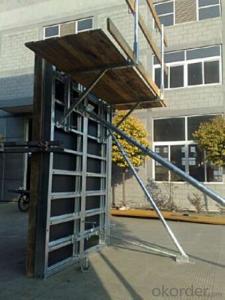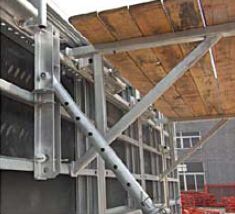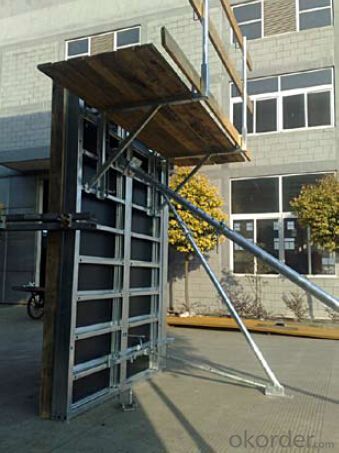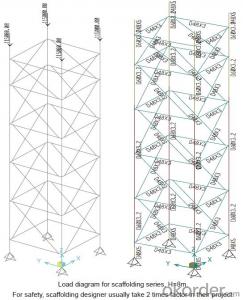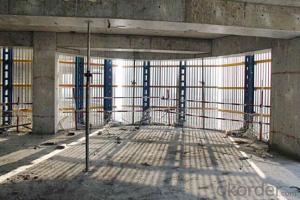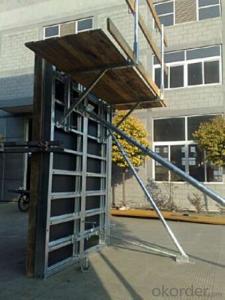Steel-frame Formwork working platform
- Loading Port:
- China Main Port
- Payment Terms:
- TT OR LC
- Min Order Qty:
- -
- Supply Capability:
- -
OKorder Service Pledge
OKorder Financial Service
You Might Also Like
Steel-frame Formwork SF-140
Characteristics:
◆ Few parts for fast forming.
◆ Max. Concrete pressure: 80KN/m2.
◆ Hot-dip galvanized steel frame.
◆ The thickness of plywood is 18mm & the panel is 14cm.
◆ Compatibility with Hunnebeck Manto system due to similar edge profile.
System Details & Application:
◆ Neat joint and fast assembling with aligning panel clamp.
◆ Flexible panel arrangement and height extension.
◆ The selection of panels.
◆ Kinds of panel connectors.
◆ Corner clamp application.
◆ Length adjustment application.
◆ Height adjustment & aligning strut.
◆ Walkway bracket & platform.
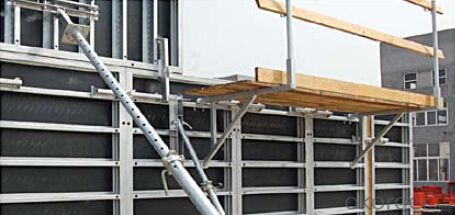
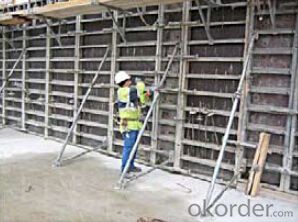
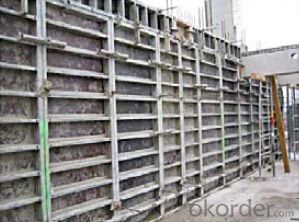
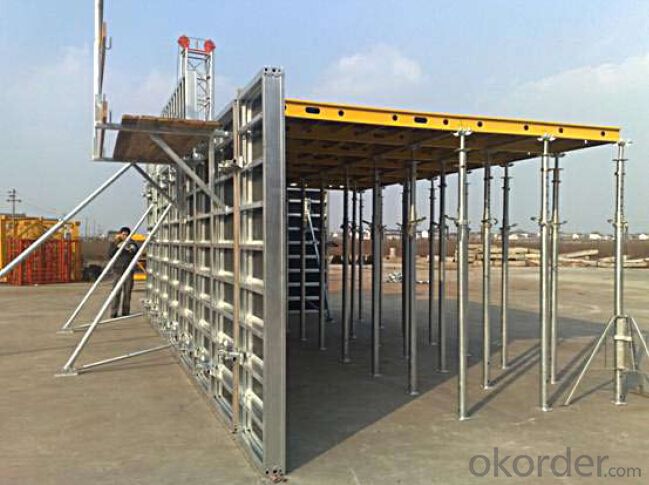
- Q: What are the different types of concrete finishes achievable with steel formwork?
- Different types of concrete finishes can be achieved using steel formwork, each offering a distinct aesthetic and functional appeal. 1. A smooth finish can be created on the concrete surface using steel formwork. This is often desired for walls, floors, and countertops, providing a sleek and polished look. Achieving this finish requires the use of high-quality formwork materials and precise installation techniques. 2. Various textured finishes can be achieved on the concrete surface with steel formwork. These textures can range from subtle patterns to more pronounced designs, adding visual interest and enhancing the overall appearance of the concrete. Architectural applications commonly utilize textured finishes to create a visually appealing and unique look. 3. An exposed aggregate finish can be achieved on the concrete surface using steel formwork. This involves removing the top layer of the concrete to reveal the aggregates, such as stones or pebbles, embedded within. Exposed aggregate finishes are popular for driveways, walkways, and decorative applications, as they provide a natural and textured appearance. 4. Steel formwork allows for stamped finishes on the concrete surface, resembling materials like brick, tile, or natural stone. This technique involves pressing molds or stamps onto the concrete before it fully sets, leaving imprints that replicate the desired pattern. Stamped finishes are commonly used for outdoor areas like patios and pool decks, offering a cost-effective alternative to natural materials. 5. Steel formwork can also be used to achieve an acid stain finish on the concrete surface. Acid staining involves applying a chemical solution that reacts with the concrete, creating unique and translucent colors. This finish is often desired in commercial and residential spaces where a more rustic and earthy look is preferred, as it enhances the natural variation and character of the concrete. In conclusion, steel formwork provides the opportunity to achieve a wide range of concrete finishes, including smooth, textured, exposed aggregate, stamped, and acid stain finishes. Each finish offers its own visual and functional benefits, enabling designers and architects to create customized and attractive concrete surfaces for various applications.
- Q: Can steel formwork be used for airport construction projects?
- Certainly, airport construction projects can make use of steel formwork. Steel formwork proves to be a versatile and long-lasting option when it comes to building various concrete structures within airports. Its attributes such as high strength, stability, and reusability offer multiple advantages, making it a suitable choice for extensive projects like airport construction. The robustness of steel formwork enables it to withstand the immense loads and pressures associated with airport infrastructure, thereby facilitating the construction of runways, taxiways, aprons, and other essential structures. Moreover, its modular design and flexibility allow for effortless customization and adaptation to cater to diverse project requirements. In summary, steel formwork emerges as a dependable selection for airport construction projects due to its durability, strength, and adaptability.
- Q: Are there any specific considerations for using steel formwork in earthquake-prone areas?
- Yes, there are specific considerations for using steel formwork in earthquake-prone areas. Steel formwork is known for its strength and durability, which is why it is often preferred in seismic regions. However, there are several factors that need to be taken into account when using steel formwork in earthquake-prone areas: 1. Flexibility: Steel formwork should be designed to have the necessary flexibility to withstand seismic forces. It should be able to absorb and dissipate the energy generated during an earthquake, reducing the risk of structural damage. 2. Connection details: The connection details between the steel formwork components should be carefully designed and engineered to ensure proper load transfer and resistance to seismic forces. Special attention should be given to the joints and connections to prevent failure or collapse during an earthquake. 3. Reinforcement: Additional reinforcement might be required to enhance the strength and stiffness of the steel formwork system. This reinforcement can be in the form of additional steel bars, cross bracing, or diagonal struts to provide increased resistance against lateral forces. 4. Anchorage: Proper anchorage of the steel formwork to the supporting structure is crucial in earthquake-prone areas. The formwork should be securely anchored to the foundation or the structural elements to prevent displacement or movement during an earthquake. 5. Inspection and maintenance: Regular inspection and maintenance of the steel formwork system are essential in earthquake-prone areas. Any damage or wear should be identified and repaired promptly to ensure the integrity and stability of the formwork system. 6. Compliance with building codes: It is important to ensure that the steel formwork system complies with the local building codes and regulations for seismic design. These codes provide guidelines and requirements for the design, installation, and use of formwork in earthquake-prone areas. By considering these specific factors, using steel formwork in earthquake-prone areas can provide enhanced structural resilience and contribute to the overall safety and durability of the construction project.
- Q: How does steel formwork accommodate for different concrete curing temperatures?
- Steel formwork is able to accommodate for different concrete curing temperatures due to its high thermal conductivity. This means that the steel transfers heat more efficiently, allowing for a faster and more uniform distribution of heat throughout the formwork. As a result, the concrete cures at a more consistent temperature, reducing the risk of uneven curing and potential structural issues. Additionally, steel formwork provides better insulation, preventing excessive heat loss or gain during the curing process, which further helps to maintain the desired temperature conditions.
- Q: What are the different transportation and storage requirements for steel formwork?
- Steel formwork, being a heavy and durable material, requires specific transportation and storage requirements. For transportation, it is crucial to have suitable vehicles with sufficient carrying capacity to accommodate the weight of the steel formwork. Additionally, proper securing and fastening mechanisms should be employed to prevent any movement or damage during transportation. Regarding storage, steel formwork should be kept in a dry and well-ventilated area to prevent corrosion. It is essential to protect the steel formwork from exposure to moisture, extreme temperatures, and direct sunlight, as these factors can deteriorate its quality. Furthermore, proper stacking methods and supports should be utilized to prevent any deformation and ensure the longevity of the steel formwork.
- Q: How does steel formwork handle concrete temperature differentials?
- Steel formwork is known for its strength and durability, which allows it to effectively handle concrete temperature differentials. The thermal conductivity of steel helps in evenly distributing the heat or cold generated by the concrete during the curing process. This prevents the formation of cracks or other structural issues that can occur due to uneven temperature distribution. Additionally, steel formwork provides stability and rigidity, ensuring that the concrete maintains its desired shape and strength even when exposed to varying temperatures.
- Q: Can steel formwork be used for both single-storey and multi-storey structures?
- Indeed, steel formwork is suitable for both single-storey and multi-storey structures. Its versatility and durability enable it to withstand the pressures and loads typically encountered in multi-storey construction. By providing a robust and rigid framework, steel formwork facilitates the pouring of concrete, facilitating the construction of walls, columns, beams, and slabs in both single-storey and multi-storey buildings. Furthermore, steel formwork boasts numerous advantages, including ease of use, reusability, and the ability to achieve high-quality finishes, rendering it a perfect selection for diverse structure types.
- Q: How does steel formwork handle different concrete surface treatments?
- Steel formwork is known for its versatility and durability in handling different concrete surface treatments. Due to its strong and rigid structure, steel formwork can effectively withstand the pressure and weight of different concrete surface treatments without deforming or collapsing. Steel formwork is commonly used in construction projects that require various surface treatments, such as smooth, textured, or patterned finishes. The steel panels and frames provide a stable and rigid surface, ensuring that the concrete is poured and cured evenly. This helps to achieve a high-quality and consistent finish. Additionally, steel formwork can easily accommodate different types of surface treatments. For instance, if a project requires a smooth finish, the steel formwork can be polished or coated with a release agent to create a smooth surface. If a project requires a textured or patterned finish, the steel formwork can be specially designed or modified to incorporate the desired texture or pattern. This flexibility allows for creativity and customization in achieving the desired aesthetics. Furthermore, steel formwork can be reused multiple times, making it cost-effective and environmentally friendly. This means that it can handle different concrete surface treatments in various projects, providing consistent and reliable results each time. In summary, steel formwork is an excellent choice for handling different concrete surface treatments due to its strength, durability, and versatility. It can withstand the pressure and weight of various finishes, accommodate different types of surface treatments, and be reused multiple times, making it a reliable and cost-effective option in construction projects.
- Q: Can steel formwork be used for curved walls?
- Curved walls can indeed be constructed using steel formwork. With its flexibility and strength, steel formwork proves to be an ideal choice for shaping curved structures. By effortlessly bending and contouring the steel panels, the desired curvature of the wall can be achieved. Moreover, the use of steel formwork guarantees exceptional concrete support, as it ensures the curved wall retains its shape throughout the pouring and curing stages. However, it should be emphasized that constructing curved walls with steel formwork may necessitate specialized knowledge and expertise in design and construction.
- Q: How does steel formwork impact the overall project scheduling?
- Steel formwork can have a significant impact on the overall project scheduling. One of the main advantages of using steel formwork is its ability to provide a faster construction process compared to traditional timber formwork. Steel formwork is known for its durability and strength, allowing for multiple reuses without compromising the quality of the concrete structure. This reusability reduces the time required for formwork installation and removal, leading to faster construction progress. Additionally, steel formwork provides a higher level of accuracy and precision in achieving desired shapes and dimensions for the concrete structure. This accuracy minimizes the need for rework and adjustments, which can save considerable time during the construction process. Furthermore, steel formwork systems are easily adjustable and adaptable, allowing for quick changes and modifications to the formwork design, if necessary. This flexibility can help to avoid delays caused by design modifications. Moreover, steel formwork is usually prefabricated off-site, meaning that it can be delivered to the construction site ready to be assembled. This off-site fabrication reduces the time required for on-site assembly, as well as the need for skilled labor and equipment. The faster installation and assembly of steel formwork contribute to overall time savings and improved project scheduling. However, it is important to note that the impact of steel formwork on project scheduling can also depend on various factors, such as the complexity of the structure, the size of the project, and the availability of skilled labor. It is crucial to carefully plan and coordinate the use of steel formwork to ensure its optimal utilization and maximize the benefits it brings to the overall project scheduling.
Send your message to us
Steel-frame Formwork working platform
- Loading Port:
- China Main Port
- Payment Terms:
- TT OR LC
- Min Order Qty:
- -
- Supply Capability:
- -
OKorder Service Pledge
OKorder Financial Service
Similar products
Hot products
Hot Searches
Related keywords

